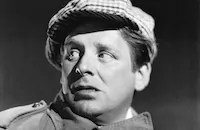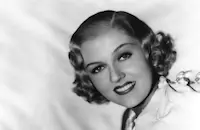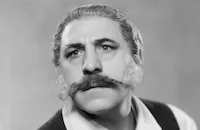Central Park

Brief Synopsis
Cast & Crew
John G. Adolfi
Joan Blondell
Wallace Ford
Guy Kibbee
Henry B. Walthall
John Wray
Film Details
Technical Specs

Synopsis
Dot and Rick, both unemployed, meet over two hot dogs that Dot has stolen from a Central Park stand. After sharing the meal, they separate to look for work, agreeing to meet for lunch. On her way out of the park, Dot is picked up by a police car. Inside, Nick Sarno offers her a strange undercover job. In the park men's room, Rick meets Charlie, a park policeman, who sends him to the police station to see about a job washing motorcycles. Charlie's eyesight has gotten very bad, but he keeps it a secret, hoping nothing will happen before he retires in a week. Charlie learns from Eby, a zoo employee, that former zoo keeper Smiley has escaped from the mental institution. At lunch, when Dot and Rick meet, Dot admits that she isn't sure the deal she was offered by Nick is legitimate. Rick advises her to take it, but when he leaves the lunchroom, he is picked up by two of Nick's men and taken to a room where they hold him captive. Rick now knows that Dot is being used by Nick's men, who intend to rob a beauty contest fund raiser that is supposed to benefit the unemployed. Meanwhile, at the zoo, Charlie greets a man standing some distance away, failing to recognize insane Smiley. Smiley steals Charlie's keys, locks him in a room, and attacks Luke, another zoo keeper, pushing him into the lion's cage. The park crew hears Luke's screams and releases him, but the lion escapes in the confusion and Charlie is suspended for failing his duty. Rick escapes and finally convinces the police that a robbery is going on inside the fund raiser. A shootout ensues and Rick chases after the escaping thieves. The escape car crashes near the bench where Charlie is resting. When Charlie investigates the crash, Nick shoots him. Rick arrives in time to capture Nick, but the police are convinced that Rick is really the thief. Just before he dies, Charlie clears Rick. After the lion is captured, Smiley is picked up and Rick and Dot leave Central Park together.

Director

John G. Adolfi
Cast

Joan Blondell

Wallace Ford

Guy Kibbee

Henry B. Walthall

John Wray

Harold Huber

Patricia Ellis

Charles Sellon
Spencer Charters

Holmes Herbert

Dewitt Jennings

Henry Armetta
Willard Robertson
Harry Holman
William Pawley
Wade Boteler
Edward Le Saint

Irving Bacon
G. Pat Collins

William Davidson
Lee Shumway
Harry Seymour
Jack Carlyle
Crew

Film Details
Technical Specs

Articles
Central Park (1932) - Central Park
Central Park packs a lot of story threads into its 57-minute running time. Set in and around New York's famous park, the film opens as Dot and Rick meet at a hot dog stand. Neither can afford to buy one of the stand's delicious wieners, because both are unemployed. When a baseball flies into the stand, causing a commotion, Dot grabs two hot dogs and runs. She shares her bounty with Rick, and the two agree to meet later for lunch after each has searched for work. Rick meets a kindly policeman, Charlie, who steers him to the local station to check on a job washing motorcycles. Dot also runs into the cops, but her contacts are not who they claim to be. Posing as undercover detectives, two criminals offer her a peculiar opportunity to make money at a fundraiser to benefit the unemployed. Though she is suspicious, she takes the job because she is broke and down on her luck. After Dot confides her worries to Rick over lunch, the two underworld figures disguised as detectives pick up Rick as she leaves the park and lock him in a room.
Charlie learns from a park zoo employee, Eby, that a former zookeeper, Smiley, has escaped from the mental institution. Later, Charlie runs into Smiley, but he fails to recognize the insane escapee because his eyesight is so poor. Smiley steals Charlie's keys and then locks the new zookeeper into the lion's cage. In the confusion, the lion escapes.
Rick gets out of his predicament and heads toward the fundraiser at the Central Park Casino, realizing that Dot is being used to divert attention while the two criminals attempt to rob the Casino. The patrons at the fundraiser are not only terrorized by the gunmen but also by the lion who strolls into the Casino. Meanwhile, Smiley is still on the loose in the park. Despite the triple threat to the park's patrons--a pair of thieves, a savage lion, and an escaped mental patient--Rick manages to help the police restore order.
Released in 1932, Central Park was one of ten films starring Joan Blondell to hit the screens that year, and she is the only real star in this action-driven drama. Her star image had been quickly constructed in the summer of 1930 and circulated via 20 or more movies by the time Central Park was released. Blondell played sassy working-class girls whose hardened exterior and wise-cracking patter served as protection against the realities of the time. Many of her movies placed her in a Depression-era setting in which she was constantly threatened by unemployment and eviction. Her characters were down on their luck or one step away from the streets but also determined to survive with their dignity and senses of humor intact. Depending on the genre, her characters flirted, conned, stole, connived, or turned to crime to keep from walking the streets. Her characters represented the last rung on the ladder above prostitution, and the appeal of her star image was her determination not to succumb, generally by using her wits and sheer grit.
In high-profile films, Zanuck tended to cast Blondell in secondary roles alongside other female stars from the Warner Bros. stable. However, she did star in several B-films, like Central Park, which had shorter shooting schedules, fewer cast members, and shorter running times, often clocking in under an hour. Earlier in 1932, she had starred in Union Depot, another B-film that took place largely in one setting. The success of Union Depot likely inspired Central Park.
Typical for Blondell's characters, Dot is just a regular gal who is out of work and hungry, necessitating the theft of a couple of hot dogs. Dot is not a criminal; she's just down on her luck like many Americans during the Depression who found themselves committing deeds they might not have under normal circumstances. Though Dot steals food to survive, she will go only so far. When the phony detectives offer her a job, she makes it clear that she won't just do anything for money--a reference to prostitution. Not only does Dot perfectly fit Blondell's star image but Depression-weary audiences were well aware of the pitfalls for single women in a bad economy. In 1932, the New York Committee of 14 reported that unemployment was forcing many young women into prostitution or borderline occupations, noting that these women would be unable to change their circumstances once the Depression passed. The following year, the National Committee on the Care of the Transient and Homeless echoed this information. The news was disseminated in sources as diverse as The Literary Digest (January 9, 1932, p. 22) and The Ladies Home Journal (August 1933, p. 24).
The impact of the Depression on the average man and woman figures prominently in the film, and the characters' back stories provide a clear understanding of what life was like during those difficult times. Dot and Rick are both unemployed, and times are so bad that the two can't even hope for a permanent job. Their best bet is to land day jobs to earn enough money in the short term to eat and bed down for the night. Dot has been pounding the pavement for so long, her shoes have holes in the soles. Warner Bros. films from this era are so topical that they serve as a snapshot of the times--not because of the far-fetched plots but because of authentic details related to setting and character. Zanuck urged scriptwriters and directors to use news stories, magazine pieces, government reports, and contemporary popular novels as resources for storylines, plot details, and slang.
Central Park also reflects the Warner Bros. visual style during the Zanuck era. It is a marvel of stripped down, fast-paced, and no-frills filmmaking by contract director John Adolfi, who shot the film in 23 days for just over $200,000. The film opens with an aerial shot of the real Central Park, which was undoubtedly stock footage. The footage adds authenticity to the opening scenes to establish the setting, while its dynamic view of the park from the air provides the only awe-inspiring imagery in the meager film. Key scenes are performed in front of park footage that is projected via rear screen. Very few close-ups are used in the film, even on star Blondell. Dialogue scenes unfold in medium shots because they are more expedient, avoiding the additional shooting and cutting of a shot/reverse shot set-up.
A handful of character actors from the Warner Bros.' stock company appear in Central Park, most notably Guy Kibbee, who is cast against type as Charlie, the retiring cop who is losing his eyesight. Kibbee is best remembered for playing jovial or daffy types as in Warners' Depression musicals. Irving Bacon can be seen in a minor role as Oscar, while Harold Huber made his screen debut in Central Park as the heavy, Nick, who tries to lure Dot into the robbery scheme. Though not part of the Warners' stock company, former silent star Henry B. Walthall, who played the Little Colonel in The Birth of a Nation (1915), plays Eby in one of the last roles of his career.
Though a minor film, Central Park offers a decent star turn by the underappreciated Joan Blondell as well as a snapshot of the issues and concerns of Depression-era America.
Producer: Darryl F. Zanuck for First National Pictures of Warner Bros.
Director: John G. Adolfi
Screenplay: Ward Morehouse and Earl Baldwin
Cinematography: Sid Hickox
Editor: Herbert Levy
Art Director: Arthur Gruenberger
Costume Designer: Orry-Kelly
Cast: Dot (Joan Blondell), Rick (Wallace Ford), Charlie (Guy Kibbee), Eby (Henry B. Walthall), Smiley (John Wray), Nick (Harold Huber), Vivian (Patricia Ellis), Luke (Charles Sellon), Sergeant Riley (Spencer Charters), Chairman of Casino Ball (Holmes Herbert), Oscar (Irving Bacon).
BW-59m. Closed Captioning.
by Susan Doll

Central Park (1932) - Central Park
Quotes
Trivia
Notes
According to production reports in the file on the film at the AMPAS Library, the film was shot over twenty-three days for a total cost of $202,500.















